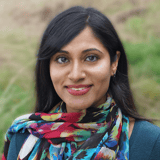Summary
Did you know that the SUS creates biases in your research, affecting one in five people? That’s right! People with disabilities, especially those who use assistive technology, are not considered by most of the questions in the SUS. As a designer, this could lead to you making design decisions that don’t take into account 20 percent of the visitors to your website. When the SUS was invented, the author encouraged people to change it to suit different needs. In this talk, Samuel Proulx from Fable will discuss how Fable adapted the SUS to work for assistive technology users. Drawing from over five thousand hours of research and testing involving assistive technology users, we created the Accessible Usability Scale (AUS). This presentation will include trends in AUS responses since it was released in December of 2020.
Key Insights
-
•
Screen readers require highly structured and semantically correct web content to enable efficient navigation for blind users.
-
•
Screen reader users often customize speed and voice settings to consume information at 400-800 words per minute, much faster than typical speech.
-
•
Alternative navigation devices, such as head mice and switch systems, rely on precise physical control and can be hindered by environmental factors like vibrations.
-
•
Current think-aloud usability testing methods create cognitive overload for assistive technology users, as they must manage device output, researcher communication, and narration simultaneously.
-
•
Travel and physical accessibility barriers severely limit the participation of people with disabilities in traditional usability labs.
-
•
Assistive technologies are highly personalized, so standard lab setups often fail to support users’ customized configurations, reducing test validity.
-
•
Standard System Usability Scale (SUS) questions inadequately capture the unique needs and experiences of assistive technology users.
-
•
Fable’s Accessible Usability Scale (AUS) adapts SUS questions to reflect assistive technology usage, improving relevance and accuracy.
-
•
Preliminary AUS results show screen reader users rate usability lower than magnification users, reflecting the greater complexity and demands of screen reader use.
-
•
Inclusive research requires adapting methods to account for varied assistive technologies, emphasizing flexibility and one-size-does-not-fit-all approaches.
Notable Quotes
"What screen readers allow us to do is to jump directly to bits of content that we are interested in to replicate the visual experience of skimming a web page."
"Most screen reader users prefer robotic voices so they can speed up the speech and read much faster than typical people."
"Alternative navigation includes things like switch systems, voice dictation, and head mice to replace standard keyboard and mouse."
"Traveling to a research lab can take longer than the research session itself for people with physical disabilities due to specialty transit."
"Every piece of assistive technology is highly customized for the individual, so labs often fail to replicate users’ ideal setups."
"The standard SUS question about needing a technical person to use the system is frustrating because many assistive tech users are very technical themselves."
"The question who are most people is confusing when applied to assistive technology users in usability scales."
"John Rucklin said if your questionnaire isn’t relevant, you can devise your own — and that’s what we did with the Accessible Usability Scale."
"Screen reader users scored in the low to mid 50s on our scale while magnification users scored around 70 and alternative navigation users around 60."
"Inclusive design is about one size fits one, not one size fits all, especially in research methodologies."
Or choose a question:
















More Videos

"Business leaders are super busy, data-driven, competitive, and have a finely tuned bullshit meter."
Doug PowellClosing Keynote: Design at Scale
November 8, 2018

"A growth mindset in research means being ready to adapt protocols based on what actually works with participants."
Mila Kuznetsova Lucy DentonHow Lessons Learned from Our Youngest Users Can Help Us Evolve our Practices
March 9, 2022

"Evan actually spent less than 15 minutes on the essay, and instead of working on homework, he was writing a letter to his significant other back home in Detroit."
Sarah GallimoreInspire Progress with Artifacts from the Future
November 18, 2022

"The ultimate measure is bringing value so people invite you back to work with them again and again."
Lada Gorlenko Sharbani Dhar Sébastien Malo Rob Mitzel Ivana Ng Michal Anne RogondinoTheme 1: Discussion
January 8, 2024

"Nobody can predict where we’re going, but we can choose to shape the future."
Alnie FigueroaThe Future of Design Operations: Transforming Our Craft
September 10, 2025

"Research is not as easy as putting on a shoe and just doing it; it requires careful consideration and alignment with imperatives."
Landon BarnesAre My Research Findings Actually Meaningful?
March 10, 2022

"I felt like a journalist pretending to be a designer."
Emily EagleCan't Rewind: Radio and Retail
June 3, 2019

"There is no solid way to control the course of your re-platforming project; being flexible is essential."
Malini RaoLessons Learned from a 4-year Product Re-platforming Journey
June 9, 2021

"At General Assembly, I learned that product management is focused more on outcomes and iterative discovery."
Asia HoePartnering with Product: A Journey from Junior to Senior Design
November 29, 2023
















